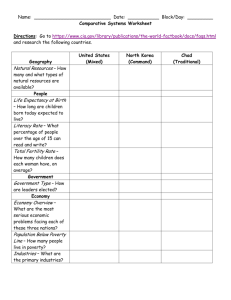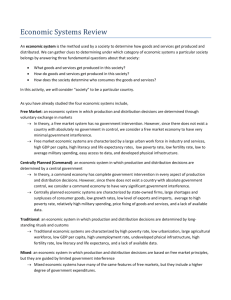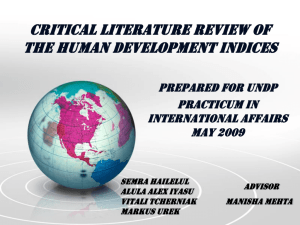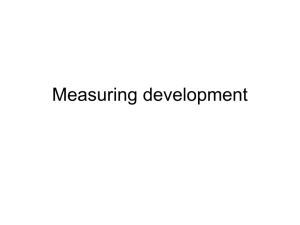Measuring Development Statistics
advertisement
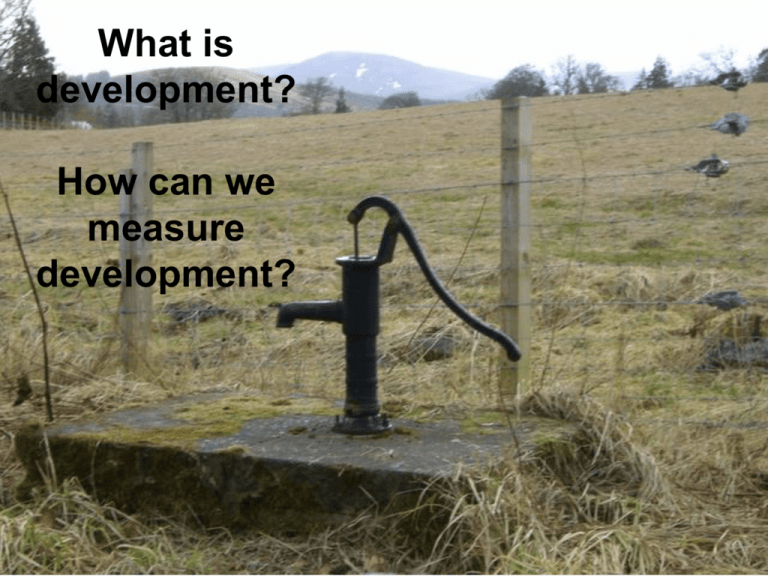
What is development? How can we measure development? Task Take 10 minutes to think about what it means to be a developed country? What would we need to measure to conclude that a country is developed? Definitions of Development Economic growth – Increase in total value of goods and services produced. (measured by GDP) Development – Improvement in human welfare, quality of life, social well being. Satisfying the population’s needs and wants. (measured using a range of socio-economic indicators) Definitions of Development Sustainable development – Sustainable development is development that meets the needs of the present without compromising the ability of future generations to meet their own needs.(Measured using indicators of environmental quality). Measuring Economic Development Gross Domestic Product GDP – total value of goods and services produced in a country (US$) Gross National Product GNP – Including income from investments abroad (US$) Measuring Economic Development GDP/GNP per capita Total value divided by the total population Purchasing Power Parity PPP – Takes into account local cost of living and is usually expressed per capita (US$). Take five minutes. Why might these not be good indicators to judge development of a country? Problems of using economic indicators such as GDP/GNP/PPP to measure development ➢Distribution of Wealth ➢Dependency on one industry (skills, location, fluctuations) Alberta Oil Newfoundland Labrador Cod Fishery ➢Tax and govt spending on public goods (War raises GDP) ➢Informal economy and unpaid work - child care and subsistence farming, bartering Problems of using economic indicators such as GDP/GNP/PPP to measure development ➢Negative aspects of economic growth are not included (eg pollution, environmental damage). ➢Environmental services such as the benefits derived from standing forest are not included. “A country should be judged on how it provides for its most vulnerable inhabitants”. You tube Clip Robert Kennedy GDP Speech. https://www.youtube.com/watch?v=77IdKF qXbUY Social Indices Demographic statistics on mortality and fertility can be used to measure development. Infant mortality rate (IMR)- number of children who die before their first birthday per 1000 live births. Life expectancy (LE) - The average number of years a person will live. Fertility rate (FR)- Number of children a woman will have in her lifetime. Literacy Rate (LR) - Percentage of adults who can read and write. Other social indices Access to safe water Access to broadband internet connection Obesity Number of people per car perception index People per doctor higher education Food consumption consumption Mortality rates for diseases air/water Crime levels Subjective life satisfaction Corruption Number in Energy Pollution levels Multiple component indices (composite indicators) These combine a number of single component indices to give a combined score. Human Development Index (0-1) HDI – PPP, life expectancy, adult literacy, average number of years schooling. The lowest ranked countries are Chad Central African Republic Congo Niger Relative / Absolute poverty The two different Human Poverty Indices reflect there are different definitions of poverty. Absolute Poverty – Those living in absolute poverty are unable to satisfy their basic needs for survival; water, clothing, food, shelter and basic medicine. World Bank figure of $1.25 per day. HDI-1 Relative Poverty – A level of poverty relative to the rest of the population of the country. For example below 50% of average earning. HDI-2 Human Poverty Index Human Poverty Index 1 (for developing countries) HPI-1 - % of pop with life expectancy of <40, % of adult illiteracy, % without safe water, % without access to health services, % of children under five who are underweight. Niger, Mali, Chad, and Afghanistan are the lowest. Human Poverty Index 2 Human Poverty Index 2 (for developed countries) HPI-2 - % of pop with life expectancy of <60, % of adult illiteracy, % of people below the poverty line (50% of medium income), rate of long term employment >12 months. Other multiple component indices (composite indicators) Gender Empowerment Measure (GEM) and Gender-related Development Index (GDI) measure gender inequality. GEM measures the ability of women to take part in political and economic activities. GDI examines gender differences in HDI indicators. Multiple component indices v single component indices Any ideas? •MCI allow for easy comparison of countries across a range of indicators. •Sometimes difficult to interpret what an MCI means. (Vietnam HDI 0.709) •MCI only indicates the aggregate score not the relative performance in each of its components. •All tend to use averages and do not reflect inequalities in wealth and income distribution Happy Planet Index Ted Talk Calculated using Life Expectancy Wellbeing “ladder” - Where on a ladder would you place your happiness 0-10. Ecological Footprint http://www.happyplanetindex.org/data/ Measuring Inequality It is possible to measure the inequality of distribution of income, land or many other indicators using the Gini coefficient. This measures the extent to which distribution varies from completely even distribution. Could be measured across the population or across different regions of the country. 0 = Complete equality (everybody has the same amount) 100 = Complete inequality (one person has all the income) Gini Coefficient World Human Development Report 2007-2008 Assignment Evaluating Statistics Development Diamonds By illustrating multiple component indices diagrammatically it is possible to compare the relative performance in each of the separate indicators. Design your own development diamond based on 4 indices which you feel give a clear picture of development. You will use this to compare your country case studies. To what extent do you think it is possible to accurately measure development and make comparisons between countries?
